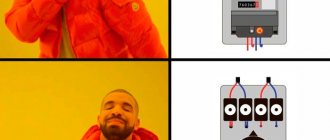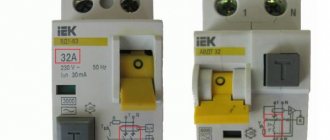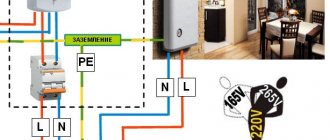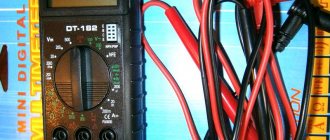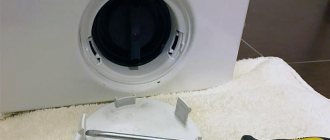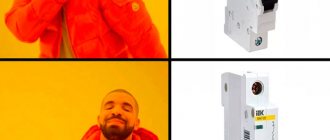What should you do if, after a certain period of proper operation, your machine or RCD in the electrical panel starts to trip when you turn on the washing machine?
Not everyone wants to immediately run to a service center, especially when the warranty has already expired. And transporting such large equipment is not an ordinary task.
In most cases, you can identify the breakdown and eliminate the cause yourself. The main thing is to know what to check and how.
Moreover, with a competent approach, it is possible to identify the cause of the shutdown even without special measuring instruments. There are several common symptoms and cases, let's look at them in order.
Problems with the electrical network or washing machine?
In order to prevent network overloads or a malfunction in the machine from completely destroying the equipment, it is necessary to establish why the meter is knocked out and eliminate the cause of the malfunction.
When the washing machine is under warranty or a complex electrical unit needs to be replaced, diagnostics and repair work must be carried out by specialists.
But perhaps the problem is in the power supply or in the contacts? Before you call a technician to your home, you need to find out why the meter goes off when you turn on the washing machine.
First you need to disconnect the device itself and household electrical appliances from the network and inspect the power circuits outside the washing machine.
See also -
Why does the washing machine jump or vibrate when spinning?
Why does the automatic machine work?
There are many reasons for knocking out an automatic rifle. Conventionally, they are divided into three groups. The first is a malfunction in the device itself, the second is difficulties with the load, the last reason is hidden in the line. Troubleshooting involves checking individual wiring lines one by one. article ⇒ Short circuit protection.
Reasons for triggering
Without load
In old houses in which worn-out and obsolete wiring has not been replaced, sudden current leaks may occur. Such unpleasant moments are associated with high air humidity, the presence of foreign objects or rodents and small animals.
The indicator shows the possible reason for the operation of the automatic device and its subsequent shutdown
In houses where the wiring has been replaced by the residents themselves, due to careless or incorrect installation in the panel, the automatic circuit breaker can often trip. Also the reasons for the failure may be:
- deformation of the protective insulation of the cable during its installation;
- the presence of cables laid in the thickness of the walls as the length of the cable twists increases;
- errors in determining the location of distribution boxes and insulation;
- incorrect selection of electrical fittings.
To understand the reasons why the automatic circuit breaker operates without a load, you should perform a detailed check of all electrical wiring. In this case, you will first have to identify which of the wiring groups is causing problems: lighting or socket group, because they are separate lines.
For example, when a machine is knocked out after turning on the lights, we can conclude that the reason lies precisely in this line. And if the automatic switch breaks when you turn on any electrical appliance, you can safely say that the problem is in the outlet line (but before that, you need to make sure that the device itself is working properly).
The differential automatic operates normally without the need to switch off
When shorting ground and zeros
The difavtomat is switched off if the device is installed incorrectly and the N and PE cables are connected in the socket or distribution box. Grounding and zero are combined on one PEN contact. If you consider the operation of the protection, you will notice that the outgoing current is divided into a pair of conductors, but only one of them goes through the differential transformer. This is why false alarms occur.
Often, inexperienced home electricians who do not have sufficient experience and do not fully understand the basics of the operation of the machine come across this question.
Under load
If the automatic circuit breaker operates periodically after connecting an electrical appliance, it can be assumed that there is an insulation fault in the electrical appliance. This suggests that using this electrical appliance is not entirely safe.
You should take all measures to identify the malfunction on your own or invite a technician to determine the cause and eliminate it.
Neglecting a malfunction can lead to serious consequences - electrical injuries to people in the house or a fire.
Tip No. 1: If the difatomat operates when connecting an electric drill, washing machine, vacuum cleaner or other equipment, you must immediately repair the device or take it to a repair shop.
When an automatic circuit breaker in an individual home trips on a functioning floor heating system, most likely the reason lies in the heating cable, which must be inspected, “ringed” and the fault repaired.
In case of voltage drop
The power supply to the circuit is turned off by the built-in diphatomat protection also when the voltage rises above the permissible value.
Not all device models can boast of having this function, but only those that have electronic control circuits installed.
The protection may also operate during switching on due to a short circuit inside the electrical appliance, since the automatic device can also turn off during a short circuit.
Also, the reason for the malfunction may be the unsatisfactory build quality of the difavtomat.
If the protection in the shield is knocked out after a certain time from being turned on, or only at a certain time of day, for example, at night, it is recommended to replace the device with a new one or an analogue from another manufacturer. But first you should make sure that such inclusions are not influenced by other factors described above.
Household reasons
As an example, consider the case of a washing machine.
First of all, it is necessary to exclude a fault from the load. To do this, connect any other household appliance - a refrigerator or an iron - to the same outlet instead of the machine. If there is no reaction from the machine, then the fault must be looked for in the washing machine itself.
When connecting a faulty washing machine to the socket, the automatic washing machine may work
Tip #2: Make sure that the phase wire is not shorted to the housing. The motor shields are excessively worn, and current flows through the graphite dust to the device.
The insulation resistance of the motor windings should be checked. When it drops below the level of 7-10 kOhm, the leakage currents reach such values that they trigger the automation.
There is no need to carry out a deeper inspection of the washing machine; it is better to call a professional to your home.
The reason for the machine tripping may not be the load. After installing repaired equipment, the problem may return again.
The reason is that the machine is switched on to the generalized leakage current in the power line: in the wiring from the load to the protection device and the machine itself.
Therefore, the total leakage current from the washing machine and the control load reaches such values that in one case the automatic machine will not turn off, but in the second it will work. Therefore, the insulation resistance in the electrical wiring should be checked.
Other reasons
In fact, the reason for the machine’s operation may be:
- high humidity penetrating the twisted wires of sockets and distribution boxes;
- unintentional deformation of electrical wiring insulation during installation with nails or screws;
- various manufacturing defects seen over time.
Finding and subsequently eliminating such faults is quite a long process and not easy even when examining open-type wiring. A break in the line and elimination of the defect is most easily accomplished by replacing the wire or installing a waterproof version instead of a regular socket.
Often you come across wires that are not of the best quality, insulated with materials that do not correspond to the class. This moment can also not be immediately determined, but subsequently all the wiring will have to be changed.
Troubleshooting
Knocking out when switching on new electrical wiring
When wiring is connected for the first time, troubleshooting should be done by checking the correct installation.
The automatic machine is first turned on in testing mode. If it works, then everything is fine with the device itself. Further actions are performed in the following sequence:
- it is necessary to make sure that there is no load;
- the machine turns on and when it is knocked out, it is concluded that the conductors are connected incorrectly;
- the connection to the N terminals of the neutral wire is checked, to the L terminal - the phase wire;
- the lower contacts of the machine are checked for correct connection of cables from the line to be monitored;
- An attempt is made to activate the protective device.
It is necessary to check where the “zero” wire comes from. It is supplied to the upper terminal from the zero bus. The “zero” is connected to the bottom contact from the line; it comes from the box. If the device is knocked out again, the reason must be sought in the connections in the switchboard.
Checking the shield
Most often, errors made during installation can be found in the panel - “zeros” from different lines are mistakenly connected or the connection points are mixed up.
When a fault occurs in the switchboard of a difavtomat, the cause may be an incorrect connection of the wires
Such mistakes are usually made by specialists who are accustomed to working only with automatic switches, for which it makes no difference which line the neutral cable is supplied from, since the devices themselves control the current on the phase cable. For an RCD or a differential circuit breaker, on the contrary, this is very important, since they react to the difference in the magnitude of currents in the phase and neutral wires.
After checking the correct connection in the distribution panel, you can turn on the machine. If it turns off again, you should make sure that the wires extending from the box to the outlet are connected correctly - the ground wire and the “zero” wire are no less often confused. If everything is correct, the machine should turn on and begin monitoring.
If you have doubts about the performance of the difavtomat itself, you can check it as follows. Using an indicator screwdriver, there is a “zero” in the socket, which is connected to ground.
Since no current flows through the phase and neutral wires without a load, the machine will not work. When you connect a load, even from a light bulb, the device will turn off. In the zero wire the current value will be 2 times less than in the phase wire.
This will trigger the electromagnetic release.
Checking the circuit
When a circuit breaker trips due to a short circuit, the cause is easiest to find. A device operating from a controlled line, as a rule, does not work. It is also equipped with fuses that blow, the body may be slightly blackened, and the wires may be slightly melted.
When connecting several devices to the line at once, the faulty device should be disconnected, and then the machine should be turned on again, which should immediately begin monitoring.
In case of a secondary shutdown, you should pay attention to the period during which this happened. If the device turns off immediately, it means it is shorting somewhere else.
Finding out the reason for the operation of the machine during a short circuit in the controlled network
Then the load should be turned off gradually - remove one consumer, turn on the machine and wait for its reaction. If the device is put under control, there is a malfunction in the disconnected device. If there is no control, we disconnect the next consumer.
Overload
If the machine does not turn off instantly when the load is connected, but some time later, we can conclude that there are overload currents, the magnitude of which is not enough for immediate operation.
Triggering of the automatic circuit breaker during overload can occur due to the connection of too powerful consumers
For this reason, the shutdown occurs due to the thermal release triggering when too many powerful appliances are connected.
If the cross-section of the electrical wiring allows, you can increase the number of sockets and install a device with a higher rated current instead of a difavtomat. article ⇒ How to avoid overloading an electrical circuit?
Plugs knock out when the washing machine is turned on: we are looking for the reason in the wiring
Due to the power supply system, the RCD circuit breaker trips in the following cases:
- When the RCD is of low quality, low capacity or incorrectly adjusted. This is the most common option and is possible when you turn on any function of the washing machine, even when draining the water. To forget about the problem, it is enough to adjust or replace the machine itself. (See also: How to choose an automatic circuit breaker (RCD) for a washing machine?)
- Increased load on the meter. When you turn on the machine, you must turn off other powerful electrical appliances, such as a microwave or electric stove.
- Damage to electrical wiring or socket. To check them, you need to connect an electrical appliance of the same power. When the RCD breaks out again, it means the reason is in the wiring.
The adjustment or replacement of the RCD must be carried out by specialists. Otherwise, unauthorized intervention in the machine, meter or traffic jams is fraught with overheating of the electrical network and ignition.
Why do you need a machine gun?
To make the reasons for knocking out traffic jams clear even to an unprepared reader, we will tell you a little more about the protection devices and why they are needed.
Some people still remember the old electric meters with plugs on the fuse links. Later, automatic shutdown plugs appeared - they did not burn out like previous devices, but were simply knocked out of the network. Modern science is developing, and they have been replaced by ready-made devices that are built into the network and turned off at the right time.
All these devices have the same operating principle - they open the network in case of excessive load and protect it from short circuits. This means they insure us against fire and fire in our home. If the safety device does not operate, the wires may melt, creating a fire hazard. In the event of a short circuit, the electrical appliances themselves may burn out.
Therefore, it is very important that the machine is not only operational, but also correctly matched to the loads on the network. And one more mandatory point: when connecting the machine, grounding is required!
Knocking out plugs: the cause of problems in the washing machine
So, the above options have been tested and not confirmed, therefore, the reason is in the device itself.
Before diagnostics or inspection, the device must be de-energized and make sure that there is no water left in the washer. Otherwise, there is a high probability of electrical and even mechanical injuries, since the washing machine contains rotating components and assemblies.
There are several reasons why traffic jams, an RCD or a meter knock out:
- due to damage to the plug or power cord;
- as a result of short circuit of the heating element;
- as a result of a malfunction of the network filter;
- due to a faulty engine;
- due to a faulty interference filter;
- as a result of a malfunction of the control button;
- due to damaged and frayed electrical wires.
Faulty socket
Electrical outlets can become damaged due to cracks or overheating. Don't delay repairing damaged sockets, they are potentially life threatening and repairing them is not a difficult or expensive task. Provided you have some knowledge of electrical engineering, this is a fairly simple job.
- Turn off the electricity in the apartment at the distribution board.
- Unscrew the bolt and remove the plastic shield. Make sure all your connections are carefully inserted into the correct terminals and securely fastened.
- Press the front bezel against the back of the case. Make sure the cables are not twisted and sit neatly inside the box so they don't get pinched when you screw the faceplate on.
- Align the bezel and secure it with the mounting screws. Make sure the bezel is level when tightening the screws.
- Place a level on top, tightening the screws one at a time unless you have a good "eye" for checking the level.
- Reinstall the jack bezel
Damage to the power cord or plug
Diagnostics always starts with the electrical wire and plug. During operation, the cord is subject to mechanical stress: it is pulled, overlapped, pinched. As a result of damage, the plug and electrical outlet do not make good contact.
Check the wire for damage with a multimeter. Replacing the power cord is as follows:
- it is necessary to turn off the power to the washing machine and close the inlet valve;
- use a hose to drain the water (turning the washing machine over is strictly prohibited);
- Unscrew the screws located around the perimeter and remove the panel;
- remove the surge protector from the housing by unscrewing the screw;
- press the latches, remove the plastic stopper by squeezing it out;
- move the electrical wire inward and to the side, thereby gaining access to the filter and disconnecting it;
- carefully pull out the power cord from the machine;
To install a new cord, you need to perform these steps in reverse order.
Damaged cable
Another reason for the RCD to trip is a faulty power cable. A sign of a wire short circuit is when the protection turns on when the washing machine starts. In order to check the power cord, you must turn off the device from the network. We take out the entire cable and inspect it.
If the reason for the machine being knocked out is the cable, then traces of a malfunction will be visible to the naked eye. Melted areas and soot are signs of a short circuit. In such a situation, the wire should be replaced completely. If you have no experience working with electrical equipment, you should contact washing machine repair specialists who will connect a new cable and conduct additional diagnostics of the equipment.
Short circuit of the heating element
Due to poor-quality water and chemicals, the heating element is “eaten up”, various impurities and scale accumulate. Heat transfer deteriorates, the heating element overheats and a short circuit occurs. As a result, the meter and traffic jams are knocked out.
To check the heater, disconnect the power cord and measure the resistance using a multimeter, setting the limit to ohm. Normally, the resistance should vary from 20 to 50 ohms.
Sometimes the heating element “shorts” to the body. To exclude this cause, the outputs and grounding bolts are measured for resistance one by one. Even a small reading on the multimeter indicates a short circuit, and this is the reason the RCD turns off.
To replace the heating element you need:
- Remove the back panel if the device is located at the rear. If the heating element is in front, first remove the control panel, then the front cover;
- Unscrew the nut of the grounding bolt approximately 6 turns, push the bolt inside;
- use a screwdriver to pry up the heating element and carefully remove it;
When replacing the heating element, do not tighten the nut tightly, since you can squeeze the heating element out of the tank.
Protective electrics of the machine
After making sure that the power cord is in good condition, you can proceed to checking the protective electronics of the washing machine. We are talking about a surge protector - a part through which the mentioned cable passes . On some models, the filter also has a “barrel”, a protruding element that combines the wire and the “network connector”.
The primary diagnosis of a surge protector is carried out visually, as in the case of wiring. Then connect the multimeter. If the part does not pass the test, then repair will not help - you need to dismantle the device and purchase a new one.
Sometimes the plugs come out when the connection between the cord and the filter is broken. The detached contacts burn out, which leads to current leakage, short circuit and tripping of the RCD. In this case, stripping the cores is not practiced - only replacing the entire “network node”, including the wiring. Otherwise, the situation will repeat itself, new failures and overloads will arise.
The surge protector cannot be repaired - the broken part must be replaced.
Leads to emergency shutdown of the RCD and “sticking” of the keys on the dashboard. During operation, the contacts on the buttons are erased, when pressed, current leaks, the network is overloaded and the machine is triggered. In this case, we proceed like this:
- partially disassemble the top of the case to remove the dashboard;
- We ring the button contacts one by one with a multimeter.
First of all, it is recommended to check the recently used buttons. Most often on Bosch machines this is the “Start/Pause” key. The next most common sticking conditions are “Spin” and “Rinse”.
Engine malfunction
The cause of a short circuit in the engine wiring occurs when the device is used for a long time or the integrity of the tank or hose is damaged. The motor contacts and the surface of the washing machine ring in turn; if a malfunction is detected, the motor is replaced and, if possible, repaired. The leak must be repaired.
In addition, the plugs or the RCD are knocked out as a result of wear on the motor brushes. In this case, they are dismantled by removing the contacts from the terminals. After installing the new brushes, manually turn the motor pulley. And if they are installed correctly, the electric motor should not make loud noise.
Description of the problem
As mentioned above, it happens that large household appliances, especially a washing machine, knock out an RCD (residual current device), plugs or machine. The equipment does not have time to complete the wash, the program stops, and at the same time the light in the entire home disappears. Sometimes it happens that there is light, but the machine still does not connect. As a rule, it is possible to detect a malfunction and cancel the cause on your own. The main thing is to have an idea of what to examine and how.
Moreover, with the right approach, it is possible to detect the cause of the shutdown even without specialized measuring instruments.
The reason should be sought in the following:
Broken and frayed electrical wires
As a rule, frayed electrical wires occur in a hard-to-reach area of the washing machine. When the device vibrates when draining water or drying, the electrical wires rub against the panel and after some time the insulation will fray. An electrical short on the body is the result of the machine being triggered. Locations of wire damage are determined visually: carbon deposits and darkened areas of melting appear on the insulating layer. These areas require soldering and re-insulation.
In conclusion, I would like to warn you: if the machine knocks when you turn on the washing machine, there is a high probability of electric shock. It is very dangerous! In addition, even minor disturbances in the electrical wiring of the device or in the electrical network lead to ignition.
Therefore, it is not recommended to turn on the RCD machine and continue washing, but it is necessary to identify and eliminate the cause of the malfunction.
See also:
- 15 best washing machines
- 15 best washing machines from 30,000 to 40,000 rubles according to customer reviews
- 5 Best Whirlpool Washing Machines Based on Customer Reviews
- 6 best Bosch washing machines according to customer reviews
- 7 best Indesit washing machines according to customer reviews
Condensation on electrical components
If you've ever seen dew on the grass in the morning, you've seen a phenomenon called condensation. And while it may be picturesque on someone's lawn, the same phenomenon can wreak havoc on your washing machine, even if they are inside an enclosure.
Choosing a durable enclosure for an electrical or electronic device means considering all the environmental hazards the device may encounter. Condensation should never be overlooked as it can allow moisture to enter the appliance.
Important! To eliminate condensation, allow the washing machine to acclimate for some time in a well-ventilated room. This process will take a matter of days.
You need to know everything stated above so that the burning smell from your machine does not ruin your life, and other, no less sad consequences of breakdowns make themselves known.
Checking the correct connection of equipment
A washing machine comes into contact with electricity and liquid at the same time, and as a result is a potentially unsafe device. Proper connection ensures the protection of people and the equipment itself.
Wires
The machine must be plugged into a grounded outlet to avoid electrical injury. It is recommended to use an individual electrical wiring line coming directly from the power distribution board. This is necessary in order to relieve other electrical wiring from overload, since a powerful thermoelectric heater (TEN) operates in the washing unit during washing.
The wiring must have 3 copper wires with a cross-section of at least 2.5 square meters. mm, with a free-standing circuit breaker and residual current device.
Washing machines have different powers up to 2.2 kW and more; they must be connected through an RCD to ensure the safety of people from electric shock. The device must be selected taking into account the power consumption. The component is designed for 16, 25 or 32 A, current leakage is 10-30 mA.
Machine
In addition, the connection of equipment can be realized through a difavtomat (circuit breaker with differential protection). Its selection occurs in the same order as the RCD. must be with the letter C. The corresponding class is marked with the letter A. There are AC class machines, but they are less suitable for operation with heavy loads.

